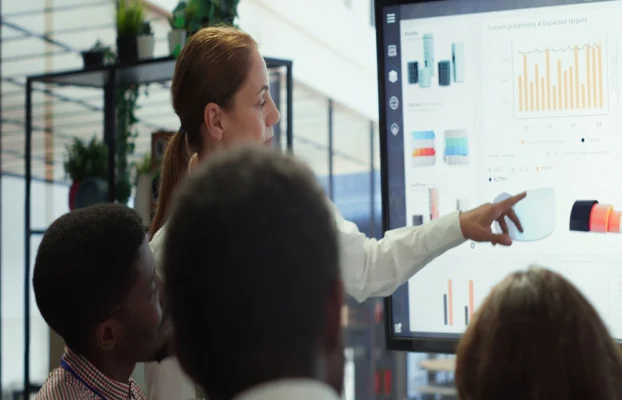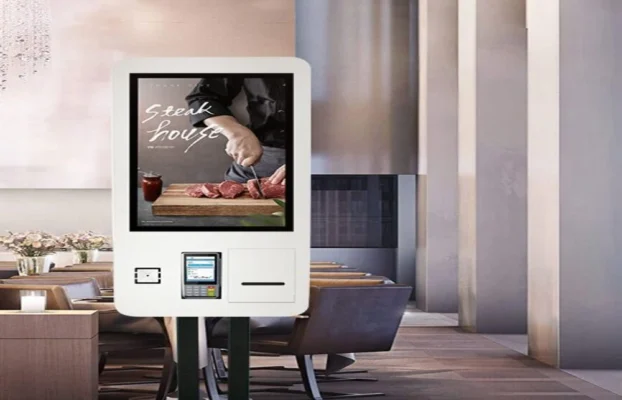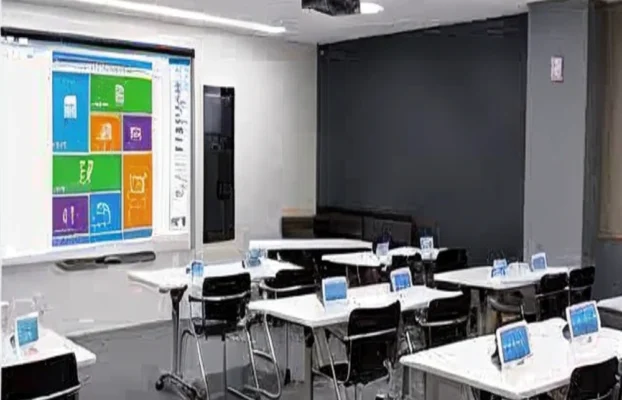In the ever-evolving landscape of retail, shopping malls are constantly seeking innovative ways to enhance the shopping experience for visitors and drive foot traffic to stores. One such innovation that has revolutionized the way malls communicate with shoppers is digital signage. Gone are the days of static posters and banners; digital signage offers dynamic, interactive, and engaging content that captivates audiences and leaves a lasting impression. In this blog post, we’ll explore the myriad benefits of digital signage usage in shopping malls and how it’s reshaping the future of retail.
 Enhanced Visual Appeal
One of the most apparent advantages of digital signage in shopping malls is its ability to captivate attention with vibrant visuals and dynamic content. Unlike traditional static displays, digital signage allows for the seamless integration of videos, animations, and interactive elements, creating an immersive experience for shoppers. Whether it’s showcasing the latest fashion trends, promoting upcoming sales events, or featuring compelling brand stories, digital signage commands attention and elevates the overall aesthetic appeal of the mall environment.
Real-Time Updates and Flexibility
In a fast-paced retail environment, staying agile and adaptable is crucial to remaining competitive. Digital signage offers unparalleled flexibility, allowing mall operators to update content in real-time to reflect changing promotions, events, or seasonal campaigns. Whether it’s announcing flash sales, promoting pop-up shops, or broadcasting live feeds of events, digital signage enables malls to keep shoppers informed and engaged with up-to-the-minute information.
Enhanced Visual Appeal
One of the most apparent advantages of digital signage in shopping malls is its ability to captivate attention with vibrant visuals and dynamic content. Unlike traditional static displays, digital signage allows for the seamless integration of videos, animations, and interactive elements, creating an immersive experience for shoppers. Whether it’s showcasing the latest fashion trends, promoting upcoming sales events, or featuring compelling brand stories, digital signage commands attention and elevates the overall aesthetic appeal of the mall environment.
Real-Time Updates and Flexibility
In a fast-paced retail environment, staying agile and adaptable is crucial to remaining competitive. Digital signage offers unparalleled flexibility, allowing mall operators to update content in real-time to reflect changing promotions, events, or seasonal campaigns. Whether it’s announcing flash sales, promoting pop-up shops, or broadcasting live feeds of events, digital signage enables malls to keep shoppers informed and engaged with up-to-the-minute information.
 Targeted Messaging and Personalization
One of the most powerful aspects of digital signage is its ability to deliver targeted messaging and personalized content based on factors such as time of day, location within the mall, and demographic data. By leveraging analytics and consumer insights, malls can tailor content to specific audience segments, ensuring that each shopper receives relevant and impactful messaging. Whether it’s recommending nearby dining options during lunchtime or promoting beauty products to shoppers in the cosmetics department, digital signage enables malls to deliver personalized experiences that resonate with consumers on a deeper level.
Interactive Experiences
Beyond simply broadcasting static advertisements, digital signage can facilitate interactive experiences that actively engage shoppers and encourage participation. Whether it’s interactive wayfinding maps, virtual try-on experiences, or social media integrations, digital signage transforms passive viewers into active participants, fostering a sense of excitement and interactivity within the mall environment. By gamifying the shopping experience and offering incentives for engagement, malls can drive increased dwell time, foot traffic, and ultimately, sales.
Targeted Messaging and Personalization
One of the most powerful aspects of digital signage is its ability to deliver targeted messaging and personalized content based on factors such as time of day, location within the mall, and demographic data. By leveraging analytics and consumer insights, malls can tailor content to specific audience segments, ensuring that each shopper receives relevant and impactful messaging. Whether it’s recommending nearby dining options during lunchtime or promoting beauty products to shoppers in the cosmetics department, digital signage enables malls to deliver personalized experiences that resonate with consumers on a deeper level.
Interactive Experiences
Beyond simply broadcasting static advertisements, digital signage can facilitate interactive experiences that actively engage shoppers and encourage participation. Whether it’s interactive wayfinding maps, virtual try-on experiences, or social media integrations, digital signage transforms passive viewers into active participants, fostering a sense of excitement and interactivity within the mall environment. By gamifying the shopping experience and offering incentives for engagement, malls can drive increased dwell time, foot traffic, and ultimately, sales.
 Measurable ROI and Analytics
One of the key advantages of digital signage is its ability to provide measurable ROI through analytics and data tracking. By monitoring metrics such as dwell time, engagement rates, and conversion rates, malls can gain valuable insights into the effectiveness of their digital signage campaigns and optimize content accordingly. Whether it’s A/B testing different messaging strategies, analyzing the impact of content placement, or measuring the success of promotional campaigns, digital signage provides tangible data that enables malls to make data-driven decisions and maximize their marketing efforts.
Conclusion
In an era where consumer attention is increasingly fragmented, digital signage offers a powerful solution for shopping malls to cut through the noise and capture the hearts and minds of shoppers. From enhancing visual appeal and flexibility to delivering targeted messaging and interactive experiences, digital signage has become an indispensable tool for malls seeking to stay relevant and competitive in today’s dynamic retail landscape. By harnessing the power of digital signage, malls can create immersive, personalized, and engaging experiences that drive foot traffic, foster brand loyalty, and ultimately, elevate the overall shopping experience for visitors.
Measurable ROI and Analytics
One of the key advantages of digital signage is its ability to provide measurable ROI through analytics and data tracking. By monitoring metrics such as dwell time, engagement rates, and conversion rates, malls can gain valuable insights into the effectiveness of their digital signage campaigns and optimize content accordingly. Whether it’s A/B testing different messaging strategies, analyzing the impact of content placement, or measuring the success of promotional campaigns, digital signage provides tangible data that enables malls to make data-driven decisions and maximize their marketing efforts.
Conclusion
In an era where consumer attention is increasingly fragmented, digital signage offers a powerful solution for shopping malls to cut through the noise and capture the hearts and minds of shoppers. From enhancing visual appeal and flexibility to delivering targeted messaging and interactive experiences, digital signage has become an indispensable tool for malls seeking to stay relevant and competitive in today’s dynamic retail landscape. By harnessing the power of digital signage, malls can create immersive, personalized, and engaging experiences that drive foot traffic, foster brand loyalty, and ultimately, elevate the overall shopping experience for visitors.
 Enhanced Visual Appeal
One of the most apparent advantages of digital signage in shopping malls is its ability to captivate attention with vibrant visuals and dynamic content. Unlike traditional static displays, digital signage allows for the seamless integration of videos, animations, and interactive elements, creating an immersive experience for shoppers. Whether it’s showcasing the latest fashion trends, promoting upcoming sales events, or featuring compelling brand stories, digital signage commands attention and elevates the overall aesthetic appeal of the mall environment.
Real-Time Updates and Flexibility
In a fast-paced retail environment, staying agile and adaptable is crucial to remaining competitive. Digital signage offers unparalleled flexibility, allowing mall operators to update content in real-time to reflect changing promotions, events, or seasonal campaigns. Whether it’s announcing flash sales, promoting pop-up shops, or broadcasting live feeds of events, digital signage enables malls to keep shoppers informed and engaged with up-to-the-minute information.
Enhanced Visual Appeal
One of the most apparent advantages of digital signage in shopping malls is its ability to captivate attention with vibrant visuals and dynamic content. Unlike traditional static displays, digital signage allows for the seamless integration of videos, animations, and interactive elements, creating an immersive experience for shoppers. Whether it’s showcasing the latest fashion trends, promoting upcoming sales events, or featuring compelling brand stories, digital signage commands attention and elevates the overall aesthetic appeal of the mall environment.
Real-Time Updates and Flexibility
In a fast-paced retail environment, staying agile and adaptable is crucial to remaining competitive. Digital signage offers unparalleled flexibility, allowing mall operators to update content in real-time to reflect changing promotions, events, or seasonal campaigns. Whether it’s announcing flash sales, promoting pop-up shops, or broadcasting live feeds of events, digital signage enables malls to keep shoppers informed and engaged with up-to-the-minute information.
 Targeted Messaging and Personalization
One of the most powerful aspects of digital signage is its ability to deliver targeted messaging and personalized content based on factors such as time of day, location within the mall, and demographic data. By leveraging analytics and consumer insights, malls can tailor content to specific audience segments, ensuring that each shopper receives relevant and impactful messaging. Whether it’s recommending nearby dining options during lunchtime or promoting beauty products to shoppers in the cosmetics department, digital signage enables malls to deliver personalized experiences that resonate with consumers on a deeper level.
Interactive Experiences
Beyond simply broadcasting static advertisements, digital signage can facilitate interactive experiences that actively engage shoppers and encourage participation. Whether it’s interactive wayfinding maps, virtual try-on experiences, or social media integrations, digital signage transforms passive viewers into active participants, fostering a sense of excitement and interactivity within the mall environment. By gamifying the shopping experience and offering incentives for engagement, malls can drive increased dwell time, foot traffic, and ultimately, sales.
Targeted Messaging and Personalization
One of the most powerful aspects of digital signage is its ability to deliver targeted messaging and personalized content based on factors such as time of day, location within the mall, and demographic data. By leveraging analytics and consumer insights, malls can tailor content to specific audience segments, ensuring that each shopper receives relevant and impactful messaging. Whether it’s recommending nearby dining options during lunchtime or promoting beauty products to shoppers in the cosmetics department, digital signage enables malls to deliver personalized experiences that resonate with consumers on a deeper level.
Interactive Experiences
Beyond simply broadcasting static advertisements, digital signage can facilitate interactive experiences that actively engage shoppers and encourage participation. Whether it’s interactive wayfinding maps, virtual try-on experiences, or social media integrations, digital signage transforms passive viewers into active participants, fostering a sense of excitement and interactivity within the mall environment. By gamifying the shopping experience and offering incentives for engagement, malls can drive increased dwell time, foot traffic, and ultimately, sales.
 Measurable ROI and Analytics
One of the key advantages of digital signage is its ability to provide measurable ROI through analytics and data tracking. By monitoring metrics such as dwell time, engagement rates, and conversion rates, malls can gain valuable insights into the effectiveness of their digital signage campaigns and optimize content accordingly. Whether it’s A/B testing different messaging strategies, analyzing the impact of content placement, or measuring the success of promotional campaigns, digital signage provides tangible data that enables malls to make data-driven decisions and maximize their marketing efforts.
Conclusion
In an era where consumer attention is increasingly fragmented, digital signage offers a powerful solution for shopping malls to cut through the noise and capture the hearts and minds of shoppers. From enhancing visual appeal and flexibility to delivering targeted messaging and interactive experiences, digital signage has become an indispensable tool for malls seeking to stay relevant and competitive in today’s dynamic retail landscape. By harnessing the power of digital signage, malls can create immersive, personalized, and engaging experiences that drive foot traffic, foster brand loyalty, and ultimately, elevate the overall shopping experience for visitors.
Measurable ROI and Analytics
One of the key advantages of digital signage is its ability to provide measurable ROI through analytics and data tracking. By monitoring metrics such as dwell time, engagement rates, and conversion rates, malls can gain valuable insights into the effectiveness of their digital signage campaigns and optimize content accordingly. Whether it’s A/B testing different messaging strategies, analyzing the impact of content placement, or measuring the success of promotional campaigns, digital signage provides tangible data that enables malls to make data-driven decisions and maximize their marketing efforts.
Conclusion
In an era where consumer attention is increasingly fragmented, digital signage offers a powerful solution for shopping malls to cut through the noise and capture the hearts and minds of shoppers. From enhancing visual appeal and flexibility to delivering targeted messaging and interactive experiences, digital signage has become an indispensable tool for malls seeking to stay relevant and competitive in today’s dynamic retail landscape. By harnessing the power of digital signage, malls can create immersive, personalized, and engaging experiences that drive foot traffic, foster brand loyalty, and ultimately, elevate the overall shopping experience for visitors.






